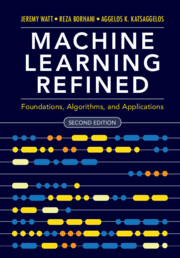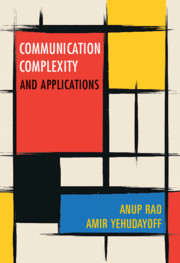Refine listing
Actions for selected content:
9096 results in Communications, Signal Processing and Information Theory
5 - Discrepancy
- from Part I - Communication
-
- Book:
- Communication Complexity
- Published online:
- 30 January 2020
- Print publication:
- 20 February 2020, pp 67-92
-
- Chapter
- Export citation
9 - Circuits and Proofs
- from Part II - Applications
-
- Book:
- Communication Complexity
- Published online:
- 30 January 2020
- Print publication:
- 20 February 2020, pp 157-174
-
- Chapter
- Export citation
7 - Compressing Communication
- from Part I - Communication
-
- Book:
- Communication Complexity
- Published online:
- 30 January 2020
- Print publication:
- 20 February 2020, pp 121-143
-
- Chapter
- Export citation
8 - Lifting
- from Part I - Communication
-
- Book:
- Communication Complexity
- Published online:
- 30 January 2020
- Print publication:
- 20 February 2020, pp 144-154
-
- Chapter
- Export citation
Index
-
- Book:
- Communication Complexity
- Published online:
- 30 January 2020
- Print publication:
- 20 February 2020, pp 250-252
-
- Chapter
- Export citation
2 - Rank
- from Part I - Communication
-
- Book:
- Communication Complexity
- Published online:
- 30 January 2020
- Print publication:
- 20 February 2020, pp 33-45
-
- Chapter
- Export citation

Machine Learning Refined
- Foundations, Algorithms, and Applications
-
- Published online:
- 05 February 2020
- Print publication:
- 09 January 2020
-
- Textbook
- Export citation

Communication Complexity
- and Applications
-
- Published online:
- 30 January 2020
- Print publication:
- 20 February 2020
4 - Advanced Diversity Techniques
-
- Book:
- Advanced Wireless Transmission Technologies
- Published online:
- 10 January 2020
- Print publication:
- 30 January 2020, pp 55-83
-
- Chapter
- Export citation
6 - Multiuser Scheduling
-
- Book:
- Advanced Wireless Transmission Technologies
- Published online:
- 10 January 2020
- Print publication:
- 30 January 2020, pp 146-178
-
- Chapter
- Export citation
Dedication
-
- Book:
- Advanced Wireless Transmission Technologies
- Published online:
- 10 January 2020
- Print publication:
- 30 January 2020, pp v-vi
-
- Chapter
- Export citation
9 - Cognitive Transmission
-
- Book:
- Advanced Wireless Transmission Technologies
- Published online:
- 10 January 2020
- Print publication:
- 30 January 2020, pp 256-302
-
- Chapter
- Export citation
12 - Application: Massive MIMO Transmission
-
- Book:
- Advanced Wireless Transmission Technologies
- Published online:
- 10 January 2020
- Print publication:
- 30 January 2020, pp 367-390
-
- Chapter
- Export citation
Contents
-
- Book:
- Advanced Wireless Transmission Technologies
- Published online:
- 10 January 2020
- Print publication:
- 30 January 2020, pp vii-x
-
- Chapter
- Export citation
10 - Application: Hybrid FSO/RF Transmission
-
- Book:
- Advanced Wireless Transmission Technologies
- Published online:
- 10 January 2020
- Print publication:
- 30 January 2020, pp 303-334
-
- Chapter
- Export citation
7 - Multiuser MIMO Transmissions
-
- Book:
- Advanced Wireless Transmission Technologies
- Published online:
- 10 January 2020
- Print publication:
- 30 January 2020, pp 179-225
-
- Chapter
- Export citation
11 - Application: Sensor Transmission with RF Energy Harvesting
-
- Book:
- Advanced Wireless Transmission Technologies
- Published online:
- 10 January 2020
- Print publication:
- 30 January 2020, pp 335-366
-
- Chapter
- Export citation
8 - Relay Transmission
-
- Book:
- Advanced Wireless Transmission Technologies
- Published online:
- 10 January 2020
- Print publication:
- 30 January 2020, pp 226-255
-
- Chapter
- Export citation
2 - Transmission Technologies for Flat Fading Channels
-
- Book:
- Advanced Wireless Transmission Technologies
- Published online:
- 10 January 2020
- Print publication:
- 30 January 2020, pp 20-40
-
- Chapter
- Export citation
Appendix: Order Statistics
-
- Book:
- Advanced Wireless Transmission Technologies
- Published online:
- 10 January 2020
- Print publication:
- 30 January 2020, pp 391-406
-
- Chapter
- Export citation
